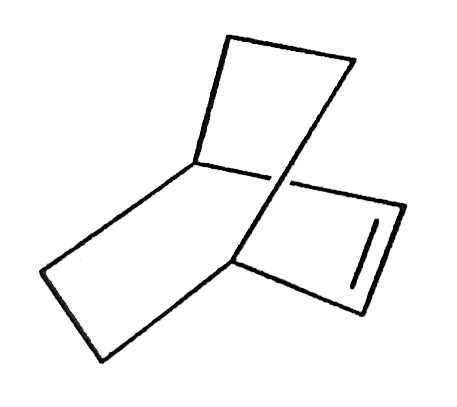Borax is converted into crystalline boron by the following steps :
Borexx−−→H2BO3Δ−−→B2O3Y−−→ΔB
X and Y are respectively :
HCl, Mg
HCl, C
C,Al
HCl, Al
To solve the problem of converting borax into crystalline boron through the specified steps, we need to identify the compounds involved in each step.
Step 1: Identify the formula of Borax
Borax is chemically represented as:
Na2B4O5(OH)4⋅5H2O
Step 2: Determine the first step (X)
The first step involves converting borax into boric acid (H3BO3). This conversion typically requires an acid. The most common acid used in this reaction is hydrochloric acid (HCl). Therefore, we can represent this step as:
Borax+HCl→H3BO3+NaCl+H2O
Thus, X=HCl.
Step 3: Identify the second step (Y)
The second step involves the conversion of boric acid (H3BO3) into boron trioxide (B2O3). This conversion is typically achieved through heating:
H3BO3Δ→B2O3+H2O
Thus, Y is heat (Δ).
Step 4: Final conversion to crystalline boron
The final step involves the reduction of boron trioxide (B2O3) to crystalline boron (B). This reduction can be achieved using a reducing agent, which is often magnesium (Mg):
B2O3+3Mg→2B+3MgO
Thus, Y=Mg.
Conclusion
Putting it all together, we have:
- X=HCl
- Y=Mg
Final Answer
X and Y are respectively:
- X=HCl
- Y=Mg
Borax is chemically represented as:
Na2B4O5(OH)4⋅5H2O
The first step involves converting borax into boric acid (H3BO3). This conversion typically requires an acid. The most common acid used in this reaction is hydrochloric acid (HCl). Therefore, we can represent this step as:
Borax+HCl→H3BO3+NaCl+H2O
Thus, X=HCl.
The second step involves the conversion of boric acid (H3BO3) into boron trioxide (B2O3). This conversion is typically achieved through heating:
H3BO3Δ→B2O3+H2O
Thus, Y is heat (Δ).
The final step involves the reduction of boron trioxide (B2O3) to crystalline boron (B). This reduction can be achieved using a reducing agent, which is often magnesium (Mg):
B2O3+3Mg→2B+3MgO
Thus, Y=Mg.
Putting it all together, we have:
- X=HCl
- Y=Mg
X and Y are respectively:
- X=HCl
- Y=Mg
Topper's Solved these Questions
- p-BLOCK ELEMENTS-1Book:VMC MODULES ENGLISHChapter:p-BLOCK ELEMENTS-1Exercise:JEE Main Archive
Explore 34 Videos
- p-BLOCK ELEMENTS-1Book:VMC MODULES ENGLISHChapter:p-BLOCK ELEMENTS-1Exercise:JEE Advanced Archive
Explore 48 Videos
- p-BLOCK ELEMENTS-1Book:VMC MODULES ENGLISHChapter:p-BLOCK ELEMENTS-1Exercise:LEVEL 1
Explore 75 Videos
- MOCK TEST 9Book:VMC MODULES ENGLISHChapter:MOCK TEST 9Exercise:CHEMISTRY (SECTION 2)
Explore 5 Videos
- PERIODIC PROPERTIES OF ELEMENTSBook:VMC MODULES ENGLISHChapter:PERIODIC PROPERTIES OF ELEMENTSExercise:IMPECCABLE
Explore 50 Videos
Similar Questions
Borax is converted into amorphous Boron by following steps
BoraxX−−→H3BO3△−−→B2O3Y−−→△B
X and Y are respectively
View SolutionCH3CH2COONH4P2O5−−→ΔXH+/H2O−−−−−→Y.
Y and X respectively are
View SolutionAmorphous boron is extracted from borax by the following steps :
Borax(A)−−→H3BO3Heat−−→B2O3(B)−−→Boron(A)and(B)are
(a) H2SO4,Al
(b) HCl, Carbon
( c) H2SO4,Mg
(d) HCl,Fe.
View SolutionAmorphous boron is extracted from borax by the following steps :
Borax(A)−−→H3BO3Heat−−→B2O3(B)−−→Boron(A)and(B)are
(a) H2SO4,Al
(b) HCl, Carbon
( c) H2SO4,Mg
(d) HCl,Fe.
View SolutionCH3CH2NH2(CH3CO)2O−−−−−−−→ΔA+B, (A) and (B) are
View SolutionPh−CH3KMnO4−−−−→ΔASoda Lime−−−−−→ΔB
Compound B is :
View SolutionMg(s)+C(s)Δ−−→highTXH2O−−→Mg(OH)2+Y
X and Y are respectively:
View SolutionThe following sequence of reactions is used to convert borax into boron (B).
Na2[B4O5(OH)4]Borax.8H2Ox−−→H3BO3Δ−−→B2O3Y−−→BBoron
Reagents X and Y are respectively
View Solution (i)O3−−−−−−−−→(ii)Zn−H2O¯:OH−−→Δ NO. of aldol condensation product.
(i)O3−−−−−−−−→(ii)Zn−H2O¯:OH−−→Δ NO. of aldol condensation product.
View SolutionConsider the following reaction sequence,
CH3C≡CHaq.H2SO4−−−−−→HgSO4APCl5−−→HeatB
The products (A) and (B) are, respectively,
View Solution
